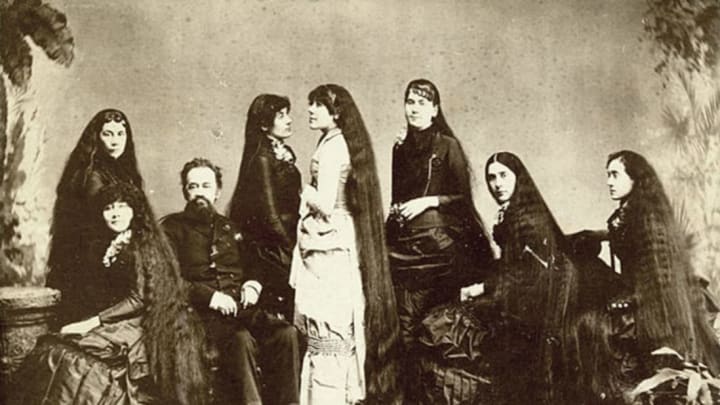Born on a small turkey farm in Niagara County, New York in the mid-19th century, the seven Sutherland sisters were unlikely candidates to build an empire of hair. According to family lore, the girls, barefoot and poor, carried the foul stench of the hair oil their mother Mary would slather on their heads every evening. Though other children might have shunned the Sutherland sisters, avoiding the unpleasant odor of the homemade hair oil, Mary Sutherland’s insistence on the ritual would prove to be a stroke of genius.
Though Mary herself wouldn’t live to see it, her daughters would eventually become some of the richest women in America. Famed for their long, thick locks, by the late 19th century, the Seven Sutherland Sisters—Sarah, Victoria, Isabella, Grace, Naomi, Dora, and Mary—were household names. Between them, the seven sisters had some 37 feet of tresses. That hair, exhibited across America, became the selling point for the Seven Sutherland Sisters’ Hair Grower, a best-selling tonic that promised American women enviable locks just like the sisters’.

George Eastman House museum via Wikimedia // Public Domain
After their mother died in 1867, their father, Fletcher Sutherland, began touring across the country with his daughters and one son. The family, rich with neither talent nor money, initially played instruments and sang at county fairs and churches in New York. At some point along the way, the single Sutherland son was removed from the act and Fletcher began billing his daughters as “The Seven Wonders.”
By 1880, the Sutherland Sisters made their Broadway debut. Though the sisters sang, audiences flocked to the shows for the sight of their long, wavy hair; they came particularly to see Victoria, whose seven feet of hair trailed behind her. The sisters ended each of their musical performances by loosening their tresses and letting their hair drape into the orchestra pit. In an era when women’s hair was the stuff of Romantic poetry and Pre-Raphaelite painting, it was undoubtedly a thrilling sight.
In 1882, Fletcher patented the Seven Sutherland Sisters’ Hair Grower tonic and began selling the oil, supposedly modeled after Mary Sutherland’s formula. The tonic took off after sister Naomi married Harry Bailey, a young entrepreneur related to James Bailey (half of Barnum and Bailey), and the sisters joined Barnum and Bailey’s Greatest Show on Earth. The collaboration with Barnum and Bailey would prove to be a financial boon to the sisters. By 1884, the tonic had earned the sisters $90,000; by 1890, the Sutherland sisters had sold $3 million worth of hair products. At the pricey sum of $1.50 a jar, the Seven Sutherland Sisters’ Hair Grower tonic became a staple on the vanity tables of middle and upper-middle class American women.

National Museum of American History, Kenneth E. Behring Center, Smithsonian Institution
This nearly full vial of the Sutherland Hair Grower is currently in the collection of the National Museum of American History in Washington, DC. The minimalist green label still attached to the bottle describes the product as an “elegant hair dressing” and promises to “render hair soft and glossy.” The Smithsonian’s bottle is a humble artifact of a fleeting moment in history when, during the late 19th century, hair growing stimulants were in vogue.
Though the tonic made the sisters rich—rich enough to build an opulent mansion in their native Niagara County—both their fame and fortune could not survive the early 20th century trend of bobbed haircuts. As the flapper bob became the hairstyle du jour, the Sutherland sisters’ long hair signified an outmoded ideal of femininity.
By 1907, the Sutherland sisters’ fortune saw a steep decline and, in 1936, the remaining two sisters closed up shop for good. Typical of rags-to-riches stories like theirs, the women burned through their fortune (their mansion, too, quite literally burned to the ground in 1938). The last of the Sutherland sisters, Grace, died penniless and all but forgotten in 1946.
